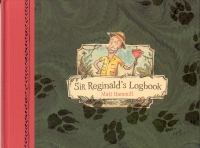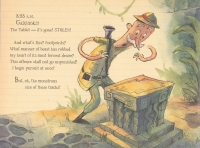| ________________
CM . . .
. Volume XV Number 5. . . .October 24, 2008
excerpt:
From the comfort of his home, Sir Reginald goes on an adventure, one that is fraught with danger at every turn, as he goes in search of the legendary Lost Tablet of Illusion that promises great powers for its owner. This marks the beginning of author-illustrator Matt Hamill's picture book Sir Reginald's Logbook, but it is clear as the story progresses that this is an unconventional narrative. Although Hamill's story has familiar elements that are part of the adventure genre, it also uses humour and self-referential techniques to give a twist on the conventional adventure story. By its doing so, Hamill's picture book will entertain young readers and, at the same time, extol the creative power of one's imagination. Hamill's story has recognizable plot, setting, and character elements from the adventure genre: the lone explorer who sets out on a dangerous quest, enemies that stand in the explorer's way of the ultimate reward, and "typical" adventure settings, such as the desolate cave, jungle, and ancient ruins with overgrown vegetation. However, Hamill uses these elements to juxtapose and blur the line between the real and the imaginary. The twist that Hamill's book provides on Sir Reginald's search for the Lost Tablet of Illusion is that his quest occurs in his imagination from the safety of his home. By its oscillating between Sir Reginald in his home and the world of adventure that Sir Reginald has created in his mind, Hamill's story draws attention to itself as a constructed narrative and emphasizes the possibilities of one's imagination for creating new and exciting worlds. The book's illustrations will increase the tale's appeal to readers. Besides contributing to the story's juxtaposition and blurring of the line between the real and the imaginary, it also enhances the contrast between the mundane and generic world of Sir Reginald's "real" life and the vivid and exciting world of his adventure. Matt Hamill uses a combination of black-and-white line drawings with watercolour. The black-and-white line drawings portray the "real" world of Sir Reginald's home and neighbourhood whereas the coloured drawings depict his quest for the Lost Tablet of Illusion. The alternating of colour with black illustrations helps to draw attention to the adventure's fictitiousness since readers will know that it is taking place in Sir Reginald's imagination rather than in actuality. Despite its fictitiousness, the adventure is still engaging and exciting for readers since the text and illustrations succeed in drawing the reader into Sir Reginald's mind and his world of adventure.
The diary format, which has become more prevalent in recent works of children's and young adult fiction, is perhaps indicative of the desire of authors who want to heighten their story's realism or to increase the personal and intimate nature of the story for their readers. The diary format gives a sense of immediacy and intimacy to the story's events because it creates the illusion that someone is recording the events as they occur. By using the diary entry format for his book, Hamill enhances this impression of "real-time" as readers will feel like they are experiencing the events along with Sir Reginald at the same time that he records these diary entries. The faint trace of notebook lines in each coloured illustration gives a nice visual touch which enhances the illusion that we are reading about an actual adventure that Sir Reginald has recorded in his diary. The story's first-person narrative style will increase readers' engagement with the story and their identification with Sir Reginald. At several points, Sir Reginald asks himself questions when he is trying to figure out what has happened, whether he is going the right way, or what he should do next. He also has exclamations of surprise, such as "Oh my! These tracks are fresh!" at some points of the story. This type of narration, coupled with the use of the present tense, will draw readers into Sir Reginald's thoughts because it increases their immediacy. Readers will feel as if Sir Reginald is thinking aloud at the moment that the events happen and that he is telling this story to someone beside him. Appropriately, the story ends just as it began, with Sir Reginald embarking on yet another adventure. Although its main audience is children, adults could also enjoy the story. The book deserves a second reading, if only to fully appreciate Hamill's humour and illustrations. Younger children may have a bit of difficulty with the book's language because there are words such as "perceive," "miraculously," and "sinuous." However, they can still enjoy the story for its humourous and engaging illustrations. With its humour and imaginative illustrations, this book would work well as a read-aloud. When sharing this book with children, teachers, librarians, and parents can have the children follow the story's pictures closely as they read along and can talk about what they see. In addition, these adults can use the book as an opportunity to get children thinking creatively about the world around them. They can emphasize the importance of creativity and having fun, since things are not always what they seem. Instead, it all depends on one's perspective and imaginativeness. For instance, what could the space beneath the backyard deck represent, or how can a blanket be used in a creative way to stand for something else? As Sir Reginald shows in this story, anything is possible within one's imagination. One doesn't need to go far to transform a mundane world into something new and exciting. To learn more about Matt Hamill and his artwork, readers can visit his official website at www.matthammill.com Recommended. Huai-Yang Lim has completed a degree in Library and Information Studies at the University of Alberta and currently works as a research specialist. He enjoys reading, reviewing, and writing children's literature in his spare time.
To comment
on this title or this review, send mail to cm@umanitoba.ca.
Copyright © the Manitoba Library Association. Reproduction for personal
use is permitted only if this copyright notice is maintained. Any
other reproduction is prohibited without permission.
NEXT REVIEW |
TABLE OF CONTENTS FOR THIS ISSUE
- October 24, 2008.
AUTHORS |
TITLES |
MEDIA REVIEWS |
PROFILES |
BACK ISSUES |
SEARCH |
CMARCHIVE |
HOME |

 The drawings are sufficiently detailed and convey a "realistic" feel to the settings of Sir Reginald's quest. As a whole, the dark shades in Hamill's illustrations enhance the danger of Sir Reginald's trek through the jungle. At the same time, the intermittent bright tones in his illustrations draw attention to specific things in the scenes, such as the monsters and the Lost Tablet of Illusion that Sir Reginald finally finds. In addition, Sir Reginald's expressions and actions are drawn well, and they will help readers identify with the character's emotions and journey. However, since Hamill does not intend to make the picture book overly frightening for young kids or for Sir Reginald's adventure to be taken too seriously by readers, his illustrations are, appropriately, somewhat cartoon-like rather than overly realistic. His close-up drawings of the monsters convey the immensity of the creatures that Sir Reginald encounters, but their fearfulness is diffused by the comical juxtapositions with Sir Reginald's other reality in which the monsters he fights are actually a pair of pants, a pair of socks, a lamp cord, a girl scout, and his pet dog.
The drawings are sufficiently detailed and convey a "realistic" feel to the settings of Sir Reginald's quest. As a whole, the dark shades in Hamill's illustrations enhance the danger of Sir Reginald's trek through the jungle. At the same time, the intermittent bright tones in his illustrations draw attention to specific things in the scenes, such as the monsters and the Lost Tablet of Illusion that Sir Reginald finally finds. In addition, Sir Reginald's expressions and actions are drawn well, and they will help readers identify with the character's emotions and journey. However, since Hamill does not intend to make the picture book overly frightening for young kids or for Sir Reginald's adventure to be taken too seriously by readers, his illustrations are, appropriately, somewhat cartoon-like rather than overly realistic. His close-up drawings of the monsters convey the immensity of the creatures that Sir Reginald encounters, but their fearfulness is diffused by the comical juxtapositions with Sir Reginald's other reality in which the monsters he fights are actually a pair of pants, a pair of socks, a lamp cord, a girl scout, and his pet dog.